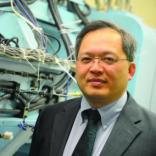Centrifuge Laboratory
Research activities by applying centrifuge modeling techniques at Columbia University can be traced back to early 1930s when Philip B. Bucky, a professor of the School of Mines, proposed the centrifuge modeling concept, and published his works on the “Use of Models for the Study of Mining Problems” in 1931 and additional papers in 1934 and 1935.
The Centrifuge Laboratory is capable of accelerating a 1,000 kg payload to 100 G, or a 550 kg payload to 200 G.
It was recognized as the first challenge in the world to use centrifuge modeling techniques for solving geotechnical engineering problems. Since then, this technology has been developed by other universities and research institutes in the United States, Japan, Russia, and Europe. Today, more than one hundred geo-centrifuges are in operation worldwide.
Decades after Prof. Bucky’s first trial, the centrifuge came back to Columbia University. In 2004, Carleton Laboratory installed a 200 g centrifuge, which was donated by the Kajima Corporation, the largest contractor in Japan. With this new piece of equipment, Carleton Laboratory once again became a top-tier centrifuge research laboratory, especially in terms of model size and capacity.
Principles of Centrifuge Modeling
By comparing the behavior of a structure with that of a small scale model, made of the same materials as its prototype, a principle of similitude may be established by the laws of mechanics, as was done in the paper by Philip B. Bucky, “Use of Models for the Study of Mining Problems” (Technical Publication 425, American Institute of Mining and Metallurgical Engineers). The principle states that if in the model the force of gravity on each part can be increased in the same proportion as the linear scale is decreased, then the unit stresses at similar points in the model and prototype will be the same, and the displacement or deflection of any point in the model will represent to scale the displacement of the corresponding point in the prototype. The effect of an increase in gravity may be obtained by substituting a centrifugal for the gravitational field, i.e., placing the model in a suitable designed centrifugal machine, or centrifuge.
(1) P. B. Bucky, A. G. Solakian and L. S. Baldin (1935) "Centrifugal Method of Testing Models." Civil Engineering, 5(5), 287-290.
Click here for more details about the centrifuge facility. For further information contact Hoe Ling at +1.212.854.1203.
Ongoing Research Projects
- Slope stability problems under rain fall and earthquake loading conditions
- Long term consolidation and settlement problems of soft clay ground
- Simulation of scouring of bridge piers
- Stability of mountain tunnel under excavation
Faculty & Staff


